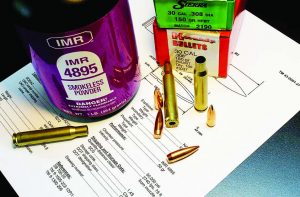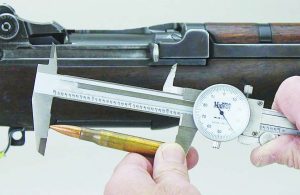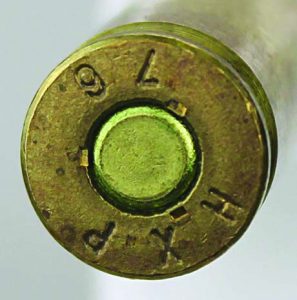by Art Merrill | Contributing Editor

The Army’s TM 43-0001-27 spells it out: 50-grains IMR 4895, 2740fps, 50,000psi.
The beginning handloader and those of us with 30+ years of experience under our belts have something in common: the learning never stops. Manufacturers introduce new powders, bullets, tools and even new cartridges every year. At the other end of the spectrum, it takes a bit of research before we can safely and successfully load an obscure cartridge that was already obsolete when Eisenhower was a corporal.
Learning also applies to cartridges that have been around a long time, and to launching their bullets from platforms different than those used by testers in the load data manual; the .30-06 and M1 Garand rifle are good examples. Few manuals tell you, and many handloaders and M1 Garand shooters I have spoken with did not know that the Garand, though chambered for the common .30-06 cartridge, needs a special diet.
Military vs civilian
Not weird-special, just a kind of low-fat special. There are two reasons for this. The first goes back to 1932, when Army Chief of Staff Gen. Douglas MacArthur directed that the M1 Garand rifle still in development would chamber the then-current .30-06 M2 Ball cartridge, and not the experimental .276 cartridge endorsed by military committees. Part of his decision was frugality: the Great Depression was on, the government had a billion .30-06 cartridges (and millions of Springfield and M1917 rifles to shoot them), and it seemed a bad fiscal idea to dump those to make a billion new .276 cartridges. Also, the .30-06 proved itself in WWI combat while the advantages of the .276 were purely theoretical.

For proper feeding in the Garand, be sure to not exceed 3.340” OAL.
The second reason is the advent of SAAMI, the Sporting Arms and Ammunition Manufacturing Institute. SAAMI sets the commercial industry standards for firearm chamber dimensions, cartridge physical dimensions and cartridge pressures; commercial firearm and ammunition manufacturers agree to adhere to those standards so that shooters can be confident that commercial ammo will properly fit and be safe to shoot in their commercial firearms.
However, SAAMI does not set standards for the military—each government decides that for itself because military and civilian needs are quite different. “Crossover” cartridges that wear both a military uniform and civvies, such as the 7.62 NATO/.308 Winchester and 5.56 NATO/.223 Remington, are not necessarily interchangeable, often causing confusion and misinformation among shooters and handloaders. We’ll deal more with those two cartridges in a later article.
 The M1 Garand is a beefy, rugged gun. Though we commonly refer to and measure cartridge pressures generated within a firearm’s chamber, we are also concerned with port pressure in the Garand—the point in the barrel where the port taps off the expanding gasses to drive the semiautomatic feeding system. The gas passes through the port (a hole drilled into the barrel) near the muzzle, where it pushes a piston on the end of the operating rod. The op rod is connected to the bolt, driving it backward to extract the fired cartridge and compress a recoil spring. The spring then drives the op rod and bolt forward again, stripping off a cartridge from the magazine and chambering it. Firing another round starts the cycle again.
The M1 Garand is a beefy, rugged gun. Though we commonly refer to and measure cartridge pressures generated within a firearm’s chamber, we are also concerned with port pressure in the Garand—the point in the barrel where the port taps off the expanding gasses to drive the semiautomatic feeding system. The gas passes through the port (a hole drilled into the barrel) near the muzzle, where it pushes a piston on the end of the operating rod. The op rod is connected to the bolt, driving it backward to extract the fired cartridge and compress a recoil spring. The spring then drives the op rod and bolt forward again, stripping off a cartridge from the magazine and chambering it. Firing another round starts the cycle again.
Routinely firing commercial ammunition, which may exceed the M1’s design of 50,000psi, can cause one of the Garand’s most-common failures, a bent op rod. When that happens, the semiauto system fails to function reliably or at all when the rod binds, or “short stroking” may cause extraction and/or feeding stoppages. If the commercial cartridge’s powder burn rate is too fast it can cause a failure-to-feed as the bolt cycles faster than the follower can raise cartridges into position for chambering. Overpressure ammo can eventually cause receiver cracking and potentially a catastrophic failure; in the extreme, several Garand “kabooms” have been attributed to commercial ammunition. The Garand is definitely a case of “better safe than sorry.”
M1 is for M2
When the US Army finally adopted the M1 Garand in 1936, John C. Garand had been developing it for nearly a decade, making repeated significant changes to comply with the changing decisions of a succession of military committees examining both the proposed .276 cartridge and several candidate semi-auto rifles. MacArthur’s order caused Garand to literally design his rifle around the M2 Ball cartridge.
That’s the important point: the M1 Garand’s gas operated semi-automatic system is designed and balanced specifically for the gas pressure developed by the M2 Ball cartridge. The M2 Ball maximum allowable gas pressure, according to Army standards, is 50,000psi. Note also that the Army standard proof pressure for testing the M1 is 67,000psi.
SAAMI standards for commercial .30-06 ammunition are quite a bit higher. SAAMI’s Maximum Average Pressure (MAP) for 10 rounds is 60,000psi. Note that this averaging means that any individual round might exceed 60,000psi and the sample of 10 will pass standards if another round is equivocally lower. Also note that the SAAMI MAP approaches the M1 Garand’s proof load.
This is not to say that all commercial .30-06 ammo is always loaded to 60,000psi. But it does mean that commercial ammo could and might reach that pressure. When we factor in the age of and wear on the Garand rifles’ gas systems intended for routine 50,000psi maximum ammunition pressures, a steady diet of commercial ammo is an invitation to cause eventual failure—like repeatedly bending a paper clip will eventually break it.
By the book

This M2 Ball has three “stab” crimps holding the primer in place. They must be swaged or reamed before reloading.
Sadly, we’re nearing the end of the supply of milsurp M2 Ball. Happily for the non-handloader, several ammo makers are producing .30-06 specifically for the Garand. Handloading for the Garand requires diligence on our part to keep pressures at or below 50,000psi; the best beginning point is to simply duplicate the US Army load. Happily again, that is simple.
Officially, that loading is 50-grains of IMR 4895 launching a 150-gr. FMJ bullet at 2,740fps. In reality, the many, many different production lots of IMR 4895 used for loading a kazillion M2 Ball cartridges varied over the decades and loads did not always reach 50-grains; it’s best the handloader start with a 45 -grain or 46-grain charge and work up from there. For bullets, Hornady’s 150-gr. FMJ BT and Sierra’s 150-gr. Matchking are excellent choices.
Military brass tends to be thicker than commercial brass, reducing case volume and raising pressure with any given load, so you may discover when using commercial brass that velocities are a tad lower. As long as you don’t exceed M2 Ball velocity, your pressures should be safe when using IMR 4895. Every handloader, especially the beginner, should be using a chronograph to infer chamber pressure; with the M1 Garand that is doubly important.
Of course, there are other suitable powders to try, as well. Looking at a chart of powder relative burn rates in your load data manual (they do differ a bit from one source to another but are in general agreement), powders slower than IMR 4320 and faster than IMR 3031 tend to develop pressures too high for the Garand before bullets reach optimum velocities.
A few final notes: Once-fired military brass will need the primer pocket crimp swaged or reamed to properly seat new primers. Use only standard rifle primers, not magnum primers. Be sure to never exceed the maximum COL (cartridge overall length) of 3.340” to ensure flawless feeding in your Garand. And of course the nature of the beast calls for full length sizing of cases and a tight bullet crimp.
Using the above powder and bullet baseline, shoot over a chronograph to ensure bullet velocities are in the ballpark, and you can be confident that you aren’t bending your Garand like a paper clip.




